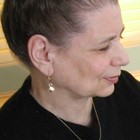Ruthy Alon, one of Moshe Feldenkrais’ first students, developed this bone building program at age 60, as a result of many years of study in the Feldenkrais Method. In the 1990s it became part of NASA’s protocol for building bone density in space. It’s also recognized by many osteopathic experts as an effective process for the prevention and reversal of osteoporosis, along with additional weight-bearing exercise.
Curious? To learn more about Ruthy, go to: https://movementintelligence.org/purpose.html. As an added bonus, go to YouTube to watch Ruthy demonstrate how to relieve back pain: https:www.youtube.com/watch?v=2bGvMe1IfCo. (Note: Ruthy is 90-years-old at this filming, and her Israeli accent is strong.)

Feldenkrais® “Meditation in Movement”
What is it like to move with less pain? To move with ease and coordination? To feel your whole self—to be aware of your limbs, hands, feet, and the center of your body—all at once?
Feldenkrais lessons have often been called “Meditation in Movement”, a process of embodied learning through movement and awareness that enables you to access your potential for spatial and kinesthetic beingness. Through Feldenkrais lessons, you learn to feel your entire self in action, creating a dynamic interaction between your nervous system, skeletal support, and the environment around you.
Testimonials and more about the Feldenkrais Method®
___________________________________________
“I had long refrained from writing about this method of countering pain because I thought it was some sort of New Age gobbledygook with no scientific basis. Boy, was I wrong! The Feldenkrais Method® is one of several increasingly popular movement techniques that attempt to better integrate the connections between mind and body. By becoming aware of how one’s body interacts with its surroundings and learning how to behave in less stressful ways, it becomes possible to relinquish habitual movement patterns that cause or contribute to chronic pain.” Jane Brody, New York Times
“I feel healthy doing these workshops! … I sense myself moving in ways I thought my body had given up years ago. Much greater flexibility. I feel transformed. Lighter, taller, more range of motion. It’s amazing how these small, detailed movements, make such a large impression on the entire body!” From Workshop Participants
“I am going to be your last teacher. Not because I’ll be the greatest teacher you may ever encounter, but because from me you will learn how to learn. When you learn how to learn, you will realize that there are no teachers, that there are only people learning and people learning how to facilitate learning.” Moshe Feldenkrais
The Feldenkrais Method® of somatic education utilizes our own nervous system’s ability to slow down, to create change, and to thereby improve daily movement by directing focus and awareness in making, and reorganizing, connections between the brain and the body. Internationally acclaimed as a type of movement education, people report lessons provide feelings of ease and lightness, reduction of pain, new strategies/coping with pain, sensing oneself taller, increased range of motion, and enhanced athletic and artistic performance.
In group classes Misha verbally guides you (does not demonstrate) through a sequence of gentle, physical movements, alternating with small periods of rest. Rest periods between the movements are as important as the movements themselves, as they provide an opportunity for reflection and resonance which brings one into a state of repose, thereby promoting effortless learning, self-awareness, and integration.
These lessons are effective for anyone, of any age, and are of benefit regardless of physical acuity. “What I’m after isn’t flexible bodies, but flexible brains. What I’m after is to restore each person to their human dignity.” – Moshe Feldenkrais
Experienced yoga practitioners develop a greater appreciation for the journey between individual actions; those shy or with any physical limitations experience less effort in how to move, and openness to pursue more movement-based processes.
Recommended reading, at your leisure, before the workshop:
Learning to Learn, by Moshe Feldenkrais: http://thefieldcenter.org/06resources/downloads/learning_to_learn.pdf
Salon article by Norman Doidge, bestselling author of The Brain’s Way of Healing:
New York Times article on using the Feldenkrais Method for pain: https://www.nytimes.com/2017/10/30/well/trying-the-feldenkrais-method-for-chronic-pain.html
